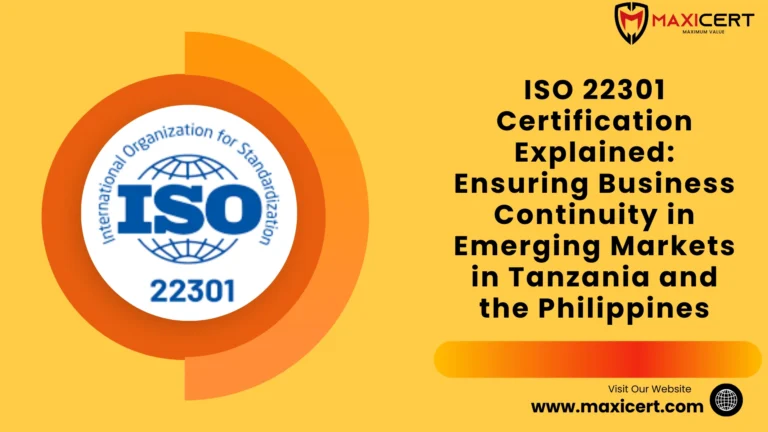ISO 22301 Certification Explained: Ensuring Business Continuity in Emerging Markets in Tanzania and the Philippines

Introduction
In Dar es Salaam, a mid-sized bank experienced an unplanned cyber disruption that paralyzed online transactions for hours. In Manila, the Philippines, a typhoon crippled operations at a leading financial institution. Not only were these incidents inconvenient—these incidents were expensive, eroding customer trust and exposing gaping holes in business continuity planning.
It is here that ISO 22301 Certification enters the picture. It is not just a compliance norm; it is a strategic tool that enables organizations to predict disruptions, reduce downtime, and ensure operational resilience. For banks, insurance businesses, fintech companies, and similar sectors operating in emerging economies, ISO 22301 is a survival lifeline.
What is ISO 22301?
ISO 22301, or the Business Continuity Management System (BCMS) standard, offers a methodical approach to threat identification, risk management, and ensuring continuity of critical business operations during disruptions.
- It leads companies to prepare ahead of time for crises rather than respond afterward.
- Certification shows dedication to operational resilience and fosters trust with clients, partners, and regulators.
- In the emerging markets of Tanzania and the Philippines, where IT disruptions, natural disasters, and political instability are the norm, ISO 22301 provides firms with a major competitive advantage.
Discover more about ISO certification services in Tanzania.
Request A Free Quote
Why Banking Needs ISO 22301
Trust is what banks and financial institutions operate on. A few hours of downtime can:
- Impact mobile banking transactions and ATMs
- Trigger customer complaints and regulatory scrutiny
- Result in financial losses and damage to reputation
ISO 22301 offers a standard to keep vital operations running despite:
- IT failures or cyber-attacks
- Power outages or system malfunctions
- Natural disasters such as typhoons or floods
External Resource:
Steps to Obtain ISO 22301 Certification
Achieving ISO 22301 may sound complex, but breaking it into actionable steps makes it manageable:
- Risk Assessment: Identify potential threats that could disrupt operations, from IT failures to environmental hazards.
- Business Impact Analysis (BIA): Pinpoint critical business processes and resources that must be preserved during disruptions.
- Develop Continuity Strategies: Set up backup systems, disaster recovery procedures, and alternative workflows.
- Training & Awareness: Equip employees with clear roles during emergencies.
- Internal Audits & Management Review: Track, assess, and continuously improve your BCMS.
- Certification Audit: Hire an accredited certification body to check your compliance.
A Real-Life Story: Bank Resilience in the Philippines
When Typhoon Haiyan struck, Bank XYZ in Manila implemented its ISO 22301-based business continuity plan. While most financial institutions were offline, Bank XYZ kept critical operations open, enabling customers to withdraw funds and make transactions. The bank’s readiness was applauded as a testament to how certification becomes real-world operational resilience.
This anecdote illustrates that ISO 22301 Certification is not simply a tickbox—it’s a useful model that insulates businesses and their clients.
Industries Other Than Banking That Benefits from ISO 22301
Banking is strongly affected, but other industries also benefit from ISO 22301:
- Healthcare: Patient care is continued even in emergencies.
- Telecommunications: Operators maintain network availability in the face of outages.
- Manufacturing: Supply lines continue to function in the event of disruptions.
- IT & Fintech: Payment systems and cloud infrastructure remain trustworthy in the face of cyber attacks.
Recommendations for Establishing ISO 22301 in Emerging Economies
Firms in Tanzania, the Philippines, and other such markets can adopt these steps for smooth implementation:
- Begin with Critical Functions: Prioritize operations that have a direct impact on customers and income.
- Involve Leadership: Planning for continuity must be at the top management level.
- Tap Technology: Cloud storage, remote connectivity, and automated notifications reduce downtime.
- Team with Experts: Seasoned ISO experts can expedite certification and guarantee compliance.
Leveraging Technology to Enhance Business Continuity
Modern technology plays a critical role in strengthening a BCMS framework.
Cloud backups ensure data accessibility during server failures.
Automated alerts improve real-time communication during crises.
AI-driven risk detection helps banks anticipate disruptions before they escalate.
Banks in Manila, for instance, are increasingly using hybrid cloud setups to keep online banking live even during typhoons.
Common Implementation Challenges and How to Overcome Them
Banks in emerging markets often face obstacles like:
Limited budget allocations for continuity planning.
Fragmented legacy systems that hinder quick response.
Cultural resistance to formal continuity processes.
Solution tips:
Build executive buy-in by showcasing financial impact.
Implement BCMS gradually—starting with critical functions.
Conduct regular awareness campaigns to change mindsets.
Conclusion
For emerging market businesses, ISO 22301 Certification is a resilience investment. If you are a Manila-based fintech company or a Dar es Salaam-based bank, the standard prepares your organization to expect disruptions, keep essential operations running, and safeguard your reputation.
Begin your ISO 22301 journey today with Maxicert ISO 22301 Certification.

Get In Touch

Get In Touch

Get In Touch
Need A Free Estimate?
Get a free consultation and Checklist to get certified for ISO , HALAL, CE Mark Certification.
FAQ
What is ISO 22301 Certification?
ISO 22301 Certification is an international standard for Business Continuity Management Systems (BCMS) that helps organizations maintain critical operations during disruptions.
Which industries benefit most from ISO 22301?
Banking, healthcare, IT & fintech, telecommunications, and manufacturing industries gain the most from ISO 22301 Certification.
How long does it take to get ISO 22301 certified?
The timeline depends on the size and complexity of your organization but generally ranges from 6 to 12 months with proper preparation.
Why is ISO 22301 important in emerging markets like Tanzania and the Philippines?
Emerging markets face unique risks such as IT outages, natural disasters, and political instability. ISO 22301 ensures continuity, builds trust, and safeguards operations against these disruptions.



